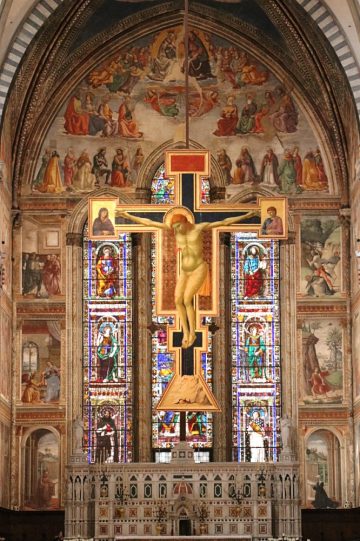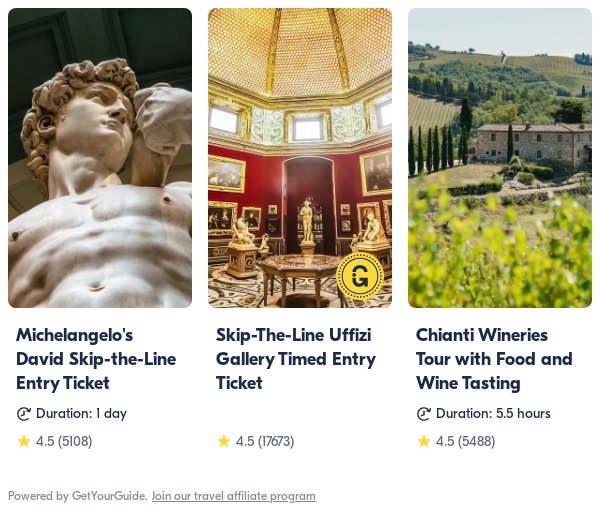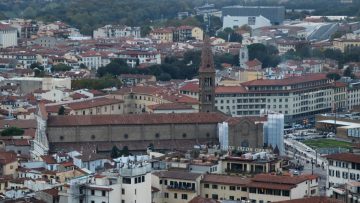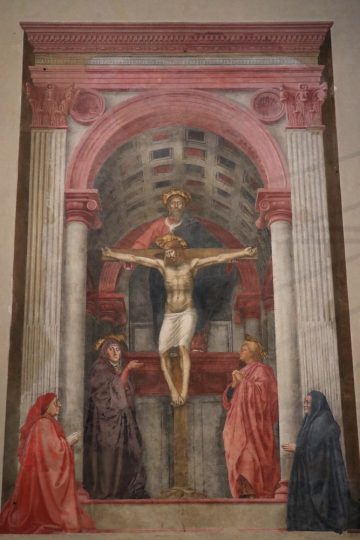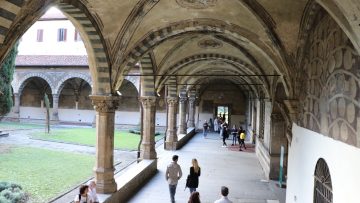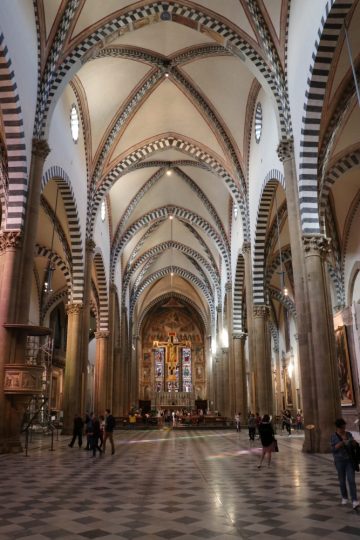Visitors to the Santa Maria Novella church see some of the finest Gothic architecture and cloisters in Florence, as well as top medieval and Renaissance art.
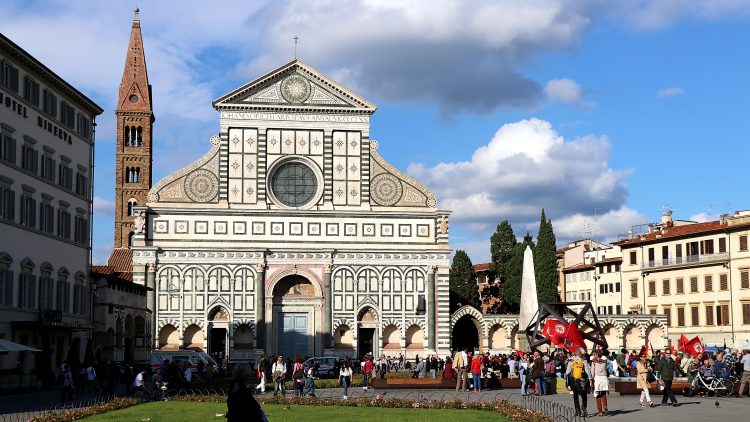
The basilica of Santa Maria Novella is one of the major churches in Florence filled with art. The large church and former Dominican monastery complex with several cloisters are mostly Gothic while the campanile still shows Romanesque elements. The marble facade introduced significant Renaissance elements. Highlights include magnificent medieval and Renaissance frescoes, a large painted crucifix by Giotto, a carved crucifix by Brunelleschi, Masaccio’s use of perspective in painting the Holy Trinity. Even unreligious visitors will find much to enjoy in the architecture and art of Santa Maria Novella.
→ Top museums, churches, and sights in Florence are open mostly as normal in 2024 — see 2024: Florence Opening Hours of Top Sights, Museums, and Churches for the latest information and opening hours. The Firenzecard is again sold while the Turbopass Florence City Pass is a good alternative that includes online timeslot reservations for both the Uffizi and Accademia.
Visit the Santa Maria Novella Complex
The Opera per Santa Maria Novella incorporates the basilica, cloisters, and a few additional museum rooms into a visit on a single ticket. The main attractions are the magnificent medieval and Renaissance frescoes in the church and in chapels off the cloisters.
The present Gothic Santa Maria Novella was the “new” church that replaced the older Santa Maria Delle Vigne (in the Vineyards) that was well outside the city walls. It was the heart of a very large Dominican monastery complex founded in 1221 that flourished until being disbanded first by Napoleon and finally in 1866. Visitors see the church and several cloisters but no further monastery buildings as such — for a look into monastic life with many cells (and art!) visit the wonderful San Marco Museum in Florence.
The complex is vast, so especially on a hot day, it is worth heading straight to the entrances. The main entrance is to the right of the facade through the Avelli Cemetery off Piazza Santa Maria Novella. A second entrance is through the museum part of the complex off the huge Piazza della Stazione that separates Santa Maria Novella from the similarly named Florence main train station.
The location near the station makes Santa Maria Novella a great choice for visiting first / last / during a stop-over. However, bear in mind that the church is large and it is easy to spend an hour to 90 minutes here without going into excessive details. The complex has no lockers or left-luggage facilities — try at the station or book somewhere in advance.
Exterior of Santa Maria Novella
The Santa Maria Novella complex is vast and much of it still enclosed by walls or by inward-looking buildings. It looks impressive from most angles but none better than the marvelous marble western facade facing Piazza Santa Maria Novella, which is nowadays used for relaxing, performances, and protests but in previous times served as a horse racing course — note the two obelisks and the oblong layout that reminds of a mini Circus Maximus.
In contrast to the admittedly impressive facade of the Duomo, the marble facade of Santa Maria Novella is actually a Renaissance original. It was designed by Leon Battista Alberti in 1470. He incorporated parts of the original Gothic facade but blended in the geometric patterns and ideas of the Renaissance. The use of scrolls for the transition of the facade hiding the lower side naves and higher main nave were unique and not used in antiquity — it inspired similar solutions in numerous later churches.
The large sun in the tympanum is the emblem of the neighborhood and the convent. The Latin inscription confirms that the facade was built in 1470 by its sponsor Giovanni Rucellai. The Rucellai family was involved in the wool trade — the family emblem is on the corniche to the right.
Further decorations on the facade are a marble astronomical dial (1674) and a bronze equinoctial armillary (1572). Somewhat ironically, Galileo Galilei was first condemned from the pulpit inside this church.
The campanile — on the other side of the church and best seen from the station side or from the cloisters — is a mixture of Romanesque and Gothic. It is 62 m high and not open to visitors.
Gothic Basilica of Santa Maria Novella

Behind the Renaissance facade of Santa Maria Novella hides a large triple-nave Gothic basilica. It was mostly constructed over a period of 80 years from around 1250. It was already long in use before the formal consecration by the pope in 1420.
Santa Maria Novella is in the form of an Egyptian cross (T-shape) with the nave 99.2 m long and up to 28.3 m high while the transept is 61.54 m. From the rear of the church, the nave appears even longer due to the piers being increasingly closer towards the apse.
Major alterations to the church interior were made in 1565 by Vasari when the rood screen was removed and many side chapels were added in the nave. Many of these were removed during renovations around 1860.
Art in the Santa Maria Novella Basilica
The church of Santa Maria Novella has always been full of art but many of the best works are now elsewhere, including in the Uffizi or Accademia (in the religious art section that most visitors rush through after seeing David). However many fine works remain in the church in addition to the hard-to-move frescoes. See also Top Art in Santa Maria Novella for more details.
Top artworks inside the basilica of Santa Maria Novella include:
- The Holy Trinity (1425-26) by Masaccio — one of the earliest works to apply the rules of perspective to painting.
- A cadaver tomb painting by Masaccio with the message — “What you are, I once was; what I am, you will become”.
- A huge 578 x 406 cm crucifix by Giotto — an early work from around 1280 of tempura and gold painted on wood.
- A rare wooden Crucifix by Brunelleschi rumored to have been as a response to Donatello’s peasant on the cross in Santa Croce.
- A half-circle lunette fresco of the Birth of Christ painted by Botticelli.
- In the Rucellai Chapel — the family that paid for the marble facade — is a Martyrdom of St Catherine by Giuliano Bugiardini (possibly with assistance from Michelangelo). The bronze tomb is by Lorenzo Ghiberti, who made the paradise doors of the baptistery at the Duomo.
Frescoes in the Chapels of Santa Maria Novella
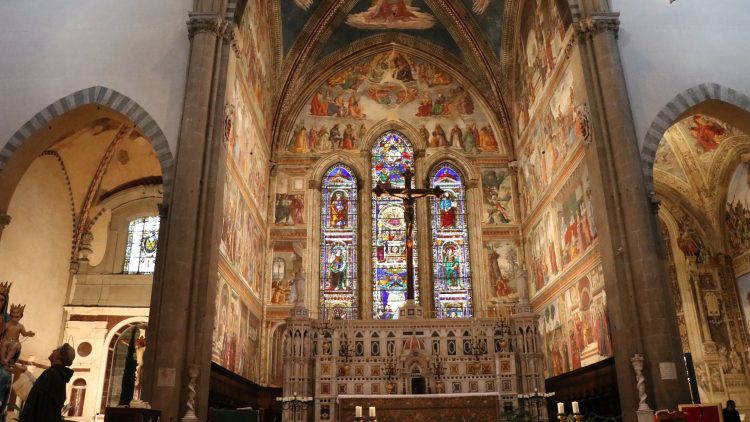
Santa Maria Novella is justifiably famous its fine frescoes, especially those in the Torbanuoni Chapel in the chancel with main altar, the Filippo Strozzi Chapel, and the Cappella Strozzi di Mantova chapel. The stained-glass windows here are mostly the originals designed by the same artists that decorated the chapels. See also Top Art in Santa Maria Novella for more detailed descriptions.
Tornabuoni Chapel
The Tornabuoni Chapel is in the chancel of the basilica with the Neo-Gothic main altar by Enrico Romoli, who directed the restoration of the church in 1860. The frescoes here were painted by Domenico Ghirlandaio from 1485 to 1490. They feature mostly scenes from the life of the Virgin (left wall), St John the Baptist (right wall), and various Dominican saints (rear wall). The frescoes are particularly valued for showing characters in typical Florentine dress of the late 15th century. According to legend, a 14-year-old Michelangelo “corrected” some of his masters drawing for these frescoes before being chased off.
Filippo Strozzi Chapel
The Filippo Strozzi Chapel, immediately to the right of the Tornabuoni Chapel, was decorated by the celebrated Renaissance painter Filipino Lippi. The frescoes depict scenes from the lives of John the Evangelist and the Apostle Philip. The main frescoes of St John include martyrdom — surviving being boiled in oil — and the resurrection of Druisana. The frescoes of Philip includes driving out a rather small dragon from the temple of Hieropolis and his martyr death by crucifixion.
Cappella Strozzi di Mantova
The frescoes in the Cappella Strozzi di Mantova are over a century older. They were mostly painted by Nardo di Cione around 1360. The frescoes were inspired by Dante’s Divine Comedy with hell and purgatory on the right wall and paradise on the left. The back wall features the Last Judgment and includes a portrait of Dante.
Opera per Santa Maria Novella Museum
The museum section of the Santa Maria Novella is mostly a result of the complicated arrangements governing ownership, use, and management that accompany many religious sites in Italy. It is more or less what would be expected to be next to a major monastery church — a couple of cloisters, some very interesting chapels, and only minor typical museum exhibition rooms. The highlight is the Spanish Chapel.
Visitors enter the Green Cloister from the north wall of the church nave (and may freely reenter the church from here — the only exit from the complex is at the far end of these cloisters to emerge just left of the facade). This large cloister was added to the church in the mid-14th century and named after the main color of the early 15th-century frescoes that depict scenes from the Book of Genesis. The best-known scenes are the well preserved Original Sin and Great Flood by Paolo Uccello.
The nearby smaller Cloister of the Dead is around a century older and still has some frescoes and other decorations. This area was long used as a cemetery.
The two rooms of the refectory is a more typical museum exhibition with the usual assortment of liturgical accouterments and vestments. It also has a variety of artworks brought here from various parts of the complex, although the best moveable pieces are now in the Uffizi or Accademia (in the religious art section that most visitors rush through after seeing David). Arguably the best paintings here are two Last Suppers — one by Allesandro Allori and the second by the nun Plautilla Nelli. The latter, measuring 7 by 2 m, was recently restored and on display since late 2019.
Behind the museum is the Dati Cloisters — now mainly visited as the only toilets in the complex are here.
Frescoes in the Spanish Chapel of Santa Maria Novella
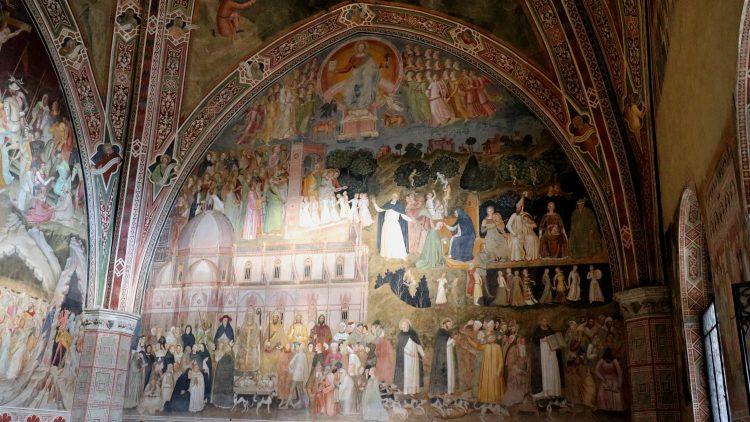
The Spanish Chapel off the Green Cloister is the clear artistic highlight of the Museum of Santa Maria Novella. It was originally the chapter house of the monastery but was granted in 1566 to the Spanish community that followed Eleonora of Toledo, wife of Duke Cosimo I de’ Medici.
The walls of this chapel are decorated by frescoes painted in 1365-67 by Andrea di Bonaiuto. The most impressive painting is the Allegory of the Active and Triumphant Church and of the Dominican order. It shows the triumph of the Roman Catholic Church over heresy. These frescoes have magnificent details in for example the clothing, decorations on buildings, animals, and vegetation.
Note the people in trees picking forbidden fruit. Other allegories of sins such as pride, lust, and avarice are probably harder for the modern observer to identify without the help of a guide.
Other frescoes show the life of Christ, St Thomas Aquinas and the importance of Christian learning. The passion of Christ is on the archway wall while the Resurrection up to Pentecost scenes are painted on the vault.
See also Top Art in Santa Maria Novella for more details on these frescoes.
Great Cloister of Santa Maria Novella
The Great Cloister (Chiostro Grande di Santa Maria Novella) is named for its size — it has 56 bays. The cloisters date from the mid-14th century and was originally surrounded by the accommodation for the monks and other monastery buildings. The frescoes here were painted in the late 16th-century frescoes at least 15 Florentine artists. However, the older frescoes in the Spanish Chapel and inside the basilica are more impressive.
This part of the complex was long used by the carabinieri but is now mostly open to visitors. A separate charge applies if there are exhibitions in any of the adjacent gallery rooms.
These cloisters offer fine views of the Romanesque-Gothic campanile of Santa Maria Novella.
Little of the original monastery interior survived. For a good look into monastic life in Renaissance Florence, visit the San Marco Museum with many striving monk’s cells and fantastic art by especially Fra Angelico.
Santa Maria Novella Visitors’ Information
The Santa Maria Novella church complex in Florence is open every day of the year but actual hours vary with the day and season.
It is usually open, as a minimum, from 9:30 to 17:00 but only opens at 11:00 on Fridays and 13:00 on Sundays and religions holidays.
The best time to visit the Santa Maria Novella complex is early morning. It is usually less busy and also less likely that unscheduled religious services will alter opening times. Visiting in the late afternoon is also good but as with so many other sights in Florence, the actual closing time depends on the guards inside, not the ticket seller or indeed time printed on the ticket, so never cut it too fine.
Admission is €7.50 (€5 for children 11 to 18) and includes the basilica and museum (and usually the Great Cloisters too but not admission to special exhibitions).
The Firenze Card is valid — a fast lane is available, or go directly to the entrance.
Audioguides are available and a good idea. Alternatively, take a good guide book or book a private tour. The free pamphlet is mostly handy for the basic map. Some of the chapels have information boards (Italian and English) to at least explain the main scenes and persons depicted.
The Santa Maria Novella church and museum complex is right across the huge piazza in front of the main train station that is named after the church. It is often possible to enter the museum from Piazza della Stazione where many buses and trams stop. The main entrance is via the Avelli Cemetery to the right (east) of the main facade on Piazza Santa Maria Novella only a few blocks from the Duomo and San Lorenzo – the Renaissance masterpiece.
See also Top Art in the Santa Maria Novella Church and Cloisters for more on the main artworks on display.
More Articles on Florence Sights
The high season in Florence is increasingly long: Easter, May, July, August, and the Christmas holidays are especially busy. November and January to mid-March are the only quiet months. Plan and book time-slot reservation tickets and tours when available in advance — the Accademia and the Uffizi are again sold out weeks in advance. Top sights are quieter directly at opening time or in the late afternoon.
→ → Special opening hours for top sights in 2024 — most sights are open normal hours in 2024 but advance time-slot reservations when available are always sensible even for sights where bookings are optional.
- Tips on Buying Tickets for the Uffizi Museum
- Tips on Buying Skip-the-Line Tickets for the Accademia (Michelangelo’s David)
- See Michelangelo’s David in the Galleria dell’ Accademia
- Visit the Duomo sights: Cathedral (Duomo), Baptistery (Battistero), Bell Tower (Campanile), Dome (Cupola), Museum (Museo), and Tickets + Opening Hours
- Visit the Bargello Museum of Sculpture (Donatello’s Davids)
- Visit San Marco Museum to see the frescoes and altarpieces painted by Fra Angelico.
- Visit Santa Maria Novella Church and Museum to see medieval and Renaissance Art.
- Visit Santa Croce for Giotto Frescoes and Michelangelo’s Grave
- San Lorenzo complex: Visit the Basilica for Renaissance Art, See the Laurentian Medici Library by Michelangelo, and Visit the Medici Chapels (Michelangelo Statues)
- Save on Sightseeing in Florence with the Firenze Card (again available but not including transportation or the Duomo sights, or consider the Turbopass Florence City Pass that includes online timeslot reservations for both the Uffizi and Accademia.
- Travel to Pisa to see the Field of Miracles and the Leaning Tower of Pisa.
- Visit the magnificent Romanesque-Gothic cathedral in nearby Siena.
- Save on top Italian designer fashion at The Mall Factory Outlet Stores.
Florence Resources
- The official Firenze Tourist Office website is a bit cumbersome but has very useful information. Especially the pdf (alternative link) with the opening hours of all major sights. Unfortunately, it is only available for the current month but it is the second last line on opening hours — the final say is the guard at the door, NOT the ticket window!
- Get Your Guide offers tours of all major sights while Tiqets sells online tickets for many top sights in Florence.
- Book luggage storage online and explore Florence more easily on foot.
- Trainline is good for booking online train tickets in Italy and most of Europe.
